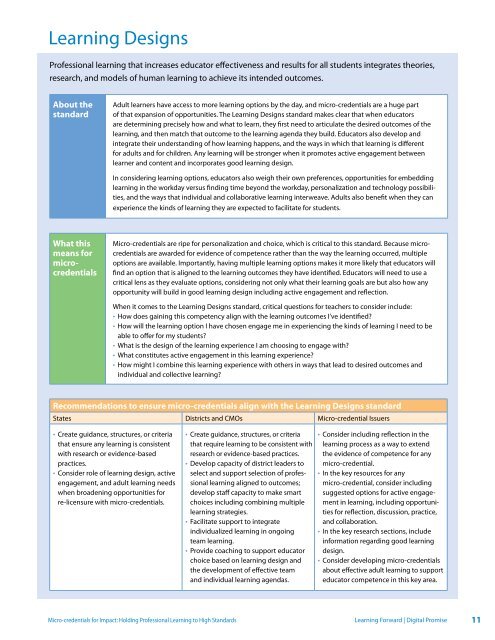Micro-credentials for Impact
2iV7zqI
2iV7zqI
Create successful ePaper yourself
Turn your PDF publications into a flip-book with our unique Google optimized e-Paper software.
Learning Designs<br />
Professional learning that increases educator effectiveness and results <strong>for</strong> all students integrates theories,<br />
research, and models of human learning to achieve its intended outcomes.<br />
About the<br />
standard<br />
Adult learners have access to more learning options by the day, and micro-<strong>credentials</strong> are a huge part<br />
of that expansion of opportunities. The Learning Designs standard makes clear that when educators<br />
are determining precisely how and what to learn, they first need to articulate the desired outcomes of the<br />
learning, and then match that outcome to the learning agenda they build. Educators also develop and<br />
integrate their understanding of how learning happens, and the ways in which that learning is different<br />
<strong>for</strong> adults and <strong>for</strong> children. Any learning will be stronger when it promotes active engagement between<br />
learner and content and incorporates good learning design.<br />
In considering learning options, educators also weigh their own preferences, opportunities <strong>for</strong> embedding<br />
learning in the workday versus finding time beyond the workday, personalization and technology possibilities,<br />
and the ways that individual and collaborative learning interweave. Adults also benefit when they can<br />
experience the kinds of learning they are expected to facilitate <strong>for</strong> students.<br />
What this<br />
means <strong>for</strong><br />
micro<strong>credentials</strong><br />
<strong>Micro</strong>-<strong>credentials</strong> are ripe <strong>for</strong> personalization and choice, which is critical to this standard. Because micro<strong>credentials</strong><br />
are awarded <strong>for</strong> evidence of competence rather than the way the learning occurred, multiple<br />
options are available. Importantly, having multiple learning options makes it more likely that educators will<br />
find an option that is aligned to the learning outcomes they have identified. Educators will need to use a<br />
critical lens as they evaluate options, considering not only what their learning goals are but also how any<br />
opportunity will build in good learning design including active engagement and reflection.<br />
When it comes to the Learning Designs standard, critical questions <strong>for</strong> teachers to consider include:<br />
• How does gaining this competency align with the learning outcomes I’ve identified?<br />
• How will the learning option I have chosen engage me in experiencing the kinds of learning I need to be<br />
able to offer <strong>for</strong> my students?<br />
• What is the design of the learning experience I am choosing to engage with?<br />
• What constitutes active engagement in this learning experience?<br />
• How might I combine this learning experience with others in ways that lead to desired outcomes and<br />
individual and collective learning?<br />
Recommendations to ensure micro-<strong>credentials</strong> align with the Learning Designs standard<br />
States Districts and CMOs <strong>Micro</strong>-credential Issuers<br />
• Create guidance, structures, or criteria<br />
that ensure any learning is consistent<br />
with research or evidence-based<br />
practices.<br />
• Consider role of learning design, active<br />
engagement, and adult learning needs<br />
when broadening opportunities <strong>for</strong><br />
re-licensure with micro-<strong>credentials</strong>.<br />
• Create guidance, structures, or criteria<br />
that require learning to be consistent with<br />
research or evidence-based practices.<br />
• Develop capacity of district leaders to<br />
select and support selection of professional<br />
learning aligned to outcomes;<br />
develop staff capacity to make smart<br />
choices including combining multiple<br />
learning strategies.<br />
• Facilitate support to integrate<br />
individualized learning in ongoing<br />
team learning.<br />
• Provide coaching to support educator<br />
choice based on learning design and<br />
the development of effective team<br />
and individual learning agendas.<br />
• Consider including reflection in the<br />
learning process as a way to extend<br />
the evidence of competence <strong>for</strong> any<br />
micro-credential.<br />
• In the key resources <strong>for</strong> any<br />
micro-credential, consider including<br />
suggested options <strong>for</strong> active engagement<br />
in learning, including opportunities<br />
<strong>for</strong> reflection, discussion, practice,<br />
and collaboration.<br />
• In the key research sections, include<br />
in<strong>for</strong>mation regarding good learning<br />
design.<br />
• Consider developing micro-<strong>credentials</strong><br />
about effective adult learning to support<br />
educator competence in this key area.<br />
<strong>Micro</strong>-<strong>credentials</strong> <strong>for</strong> <strong>Impact</strong>: Holding Professional Learning to High Standards<br />
Learning Forward | Digital Promise<br />
11


